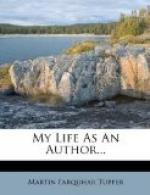one place, I noticed what seemed to be a headless
female figure, perhaps the Virgin, and as large
as life: my Jehu said he had heard that it once
had a head. We soon came to a small square inclosure,
said to be a most ancient cemetery; I scrambled
over the wall, and found among the briars and
weeds one solitary tomb of a venerable and Runic
aspect, but I soon found out that it recorded the name
of somebody who departed Ye LYFE somewhere in
1577; nothing so extremely ancient. A rough
rock-besprinkled hill now attracted me, as I
heard it was called another Carn-breh, and was surmounted
by some mound, or ruin: so out of the gig,
and up in no time. Clearly it had been an
ancient beacon place, as atop are the remains of a
small square-built terrace inclosing some upright
stones placed irregularly,—a sort
of huge fireplace. One of the neighbouring rocks
presented on its surface a fine specimen of what are
called rock basins; but unluckily for the antiquary,
this excavation is on the side of the stone,
not on the summit; so that it could not possibly
hold water, and is clearly caused by some particular
moss eating away the stone.—By three
o’clock returned to Penzance, had dinner
(it was breakfast too), bought a mineral memorial,
and in the gig again, over the sands to the outlandishly
named Mara Zion, or Market Jew, words probably
of similar import. Opposite to this little
place, and joined to it by a neck of rocks passable
at low-water, stands that picturesque gem, Mount
St. Michael. You know the sort of thing;
an abrupt, pyramid of craggy rock, crowned with an
edifice, half stronghold and half cathedral. It
is a home of the St. Aubyn family, and is well
kept up in the ancient style, but in rather a
small way: a portcullised entrance, old armour
hanging in the guard-room, a beautiful dining-hall
with carved oak roof, and panels, and chairs;
a chapel to match, with stained windows; an elegant
Gothic drawing-room, white and gold; and everything,
down to black-leather drinking jugs, in character
with the feudal stronghold. I mounted the
corkscrew tower, and got to the broken stone
lantern they call St. Michael’s chair; an uncomfortable
job, but rewarded by a splendid panorama, gilt
by the setting sun: in the chapel too, I
descended into a miserable dungeon communicating with
a monk’s stall, where doubtless some self-immured
penitent had wasted life away, only coming to
the light for matins, and only relieved from
solitary imprisonment by midnight mass. This has
been discovered but very lately in repairing
the chapel: it was walled up, and contained
a skeleton. As a matter of course, this old castle
contains a little hidden room, where that ubiquitous
vagabond, the royal Charles, laid his hunted head:
the poor persecuted debauchee sponged upon all
his friends like Bellyserious Buggins. Back
again, by water this time, to little Mara Zion, but
ever and anon looking with admiration on that
beautiful mount; the western rocks are really
magnificent, as big as the largest hay-stacks,




